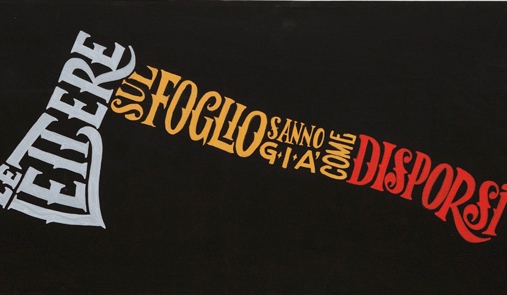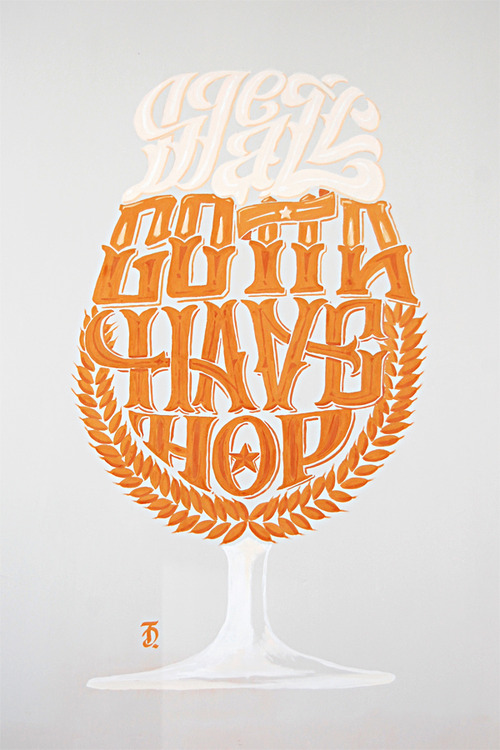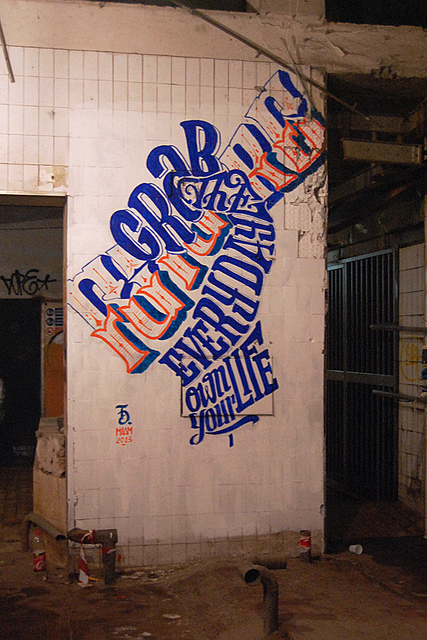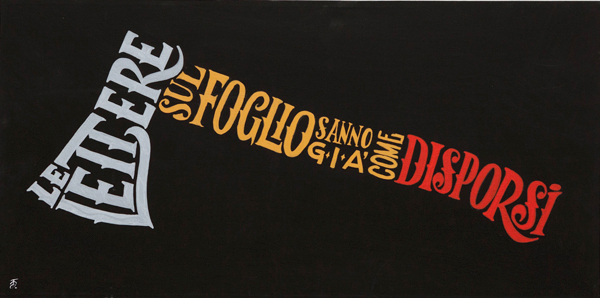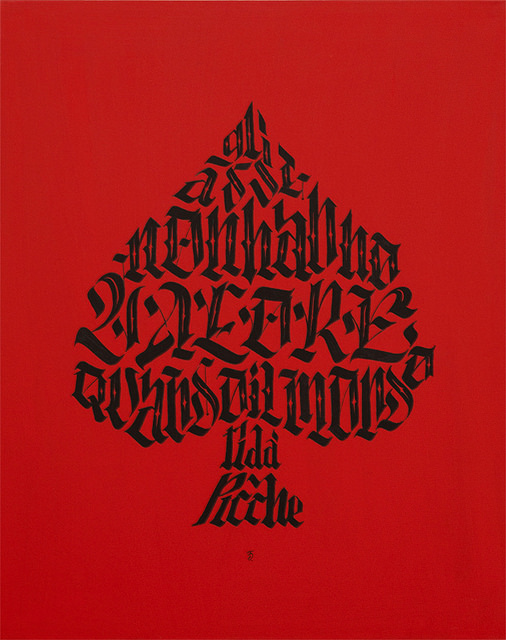Chi ha detto che un testo scritto deve necessariamente avere solo un valore comunicativo? Quando le parole si uniscono tra loro possono fare molto di più, giocano e si dispongono per dar vita ad un qualcosa che oltre al valore comunicativo abbia anche un senso estetico: il calligramma. La lettera diviene perciò il mezzo per creare una forma d’arte e si genera un mix perfetto tra impaginazione dello scritto ed effetto visivo.
Daniele Tozzi è un artista romano che ha fatto di questo strumento il suo principale espediente espressivo; dopo aver realizzato per lungo tempo graffiti con lo pseudonimo di Pepsy si è poi avvicinato al mondo della grafica e dell’hand lettering. Lo studio della lettera è sempre stata perciò una costante che lo ha accompagnato e lo accompagna tuttora nel suo percorso creativo.
A qualche settimana dalla chiusura della sua prima mostra personale, “Word Play”, tenuta nella Galleria Varsi di Roma, abbiamo avuto l’opportunità di conoscere meglio tutta la sua opera.
Cresciuto nel boom della cultura hip-hop italiana, il tuo percorso artistico prende avvio dal campo del writing arrivando a sfociare in questi anni nel graphic design. In che modo perciò si è sviluppata la tua formazione?
Diciamo che devo tutto al writing, tutto è cominciato nei primi anni del liceo dove mi sono avvicinato alla cultura hip-hop, scegliendo il writing come mia forma d’espressione preferita. Ma devo anche ammettere che la comunicazione visiva mi ha affascinato sin da piccolo, tutt’oggi non riesco a cambiare canale se c’è la pubblicità in tv. Quindi diventare grafico è stato uno sbocco naturale nel corso della mia vita, anche se separo nettamente il lavoro (attualmente per un marchio d’abbigliamento) e la passione per la scrittura.
Pepsy e Daniele Tozzi sono due persone diverse? Quanto ha influito o influisce ancora il background culturale e artistico di Pepsy nella tua attuale produzione?
Si, sono due faccie della stessa medaglia, Pepsy è il mio lato sinistro, dove ho tatuaggi e piercing, Daniele invece è tutto pulito. Daniele di giorno, Pepsy di notte. Anche se attualmente ho abbandonato la tag per le mie produzioni in galleria e su tela, l’influenza c’è sempre. Il writing ti lascia la voglia di sperimentare, di giocare con lettere, ti fa crescere vedendo luoghi e vivendo situazioni che una persona normale non potrebbe vedere, tutto questo ti rimane. Sfide con le lettere che poi si riversano nelle mie tavole di calligrafia e lettering.
Utilizzi una tecnica espressiva abbastanza singolare come quella del calligramma in cui ti trovi a dover lavorare nello stesso momento con testo ed immagini. Nel tuo caso sono le parole a dar vita alla forma o la forma che segue le parole stesse?
Il calligramma per me è il mix perfetto tra grafica, nel senso di impaginazione del testo e scrittura a mano libera. Esiste in ambito grafico e letterario da oltre 200 anni, uno dei precursori fu Apollinaire che amava scrivere versi dandogli una forma. Io ne faccio un uso più moderno, legato alla grafica. La maggior parte delle volte l’immagine viene fuori dal testo, uso spesso citazioni di canzoni della musica che ascolto e le canzoni proiettano spesso immagini nella mente. La cosa più difficile è poi trovare i caratteri giusti che rendano al meglio la forma dell’oggetto o meglio ancora che contestualizzino il testo stesso. Un carattere gotico avrà un impatto visivo nettamente differente da un carattere anni ’30 graziato.
Nelle tue opere i testi provengono da citazioni di canzoni rap: in questo genere musicale il linguaggio è fondamentale e ricco di significati e simbologie intrinsechi con ampi riferimenti alla società e alla cultura moderna. Come scegli i testi che andranno poi a trasformarsi in immagini? Ti basi sull’utilizzo grafico che devi farne o su un valore personale ed affettivo?
Tutte le opere create per la mostra “Word Play” sono tratte da citazioni di rap italiano dei miei artisti rap e delle mie canzoni preferite, quindi è sicuramente un discorso affettivo. Sono canzoni che ascolto da sempre, che hanno un significato profondo nella mia vita, riversarle su tela è più che altro un tributo alla musica che mi ha cresciuto sin da quando ero adolescente. Ci sono poi alcuni testi che appena li senti sembrano scritti apposta per me, ti faccio un esempio veloce: Lucci, noto rapper romano, nel suo ultimo disco ha fatto una canzone che diceva “le lettere sul foglio sanno già come disporsi..”, oppure “ho fatto il mio ritratto con le lettere su un foglio…”.
La Galleria Varsi, una delle più attive gallerie romane per la scena artistica urbana, ha ospitato a Luglio la tua prima personale “World Play”. Come hai vissuto il passaggio all’ambiente delle gallerie, venendo tu da una dimensione in cui la libertà espressiva è legata ad una fruizione più urbana dell’arte?
Per me è stato come essere invitato per la prima volta ad una jam di graffiti in mezzo ai migliori wirter in circolazione. Mi ha molto emozionato perché ha segnato l’inizio di un nuovo percorso, quasi ricominciare da zero a giocare e divertirmi daccapo, come quando avevo 16 anni e facevo i primi sketch a casa. Io non mi reputo uno street artist, forse lo è stato Pepsy quando faceva produzioni su muri legali grandi e piene di colore. La mia libertà d’espressione non è affatto cambiata, si tratta in fondo sempre di lettere, è cambiato solo il mezzo ovvero la tela o la carta, ma non ti nascondo che ho avuto modo di realizzare qualche disegno su muro ed è sempre una sensazione stupenda.
Già dal titolo della mostra traspare la tua volontà di giocare e far giocare con le parole. Com’è nata questa esposizione e su quali parametri ti sei basato per la scelta delle opere da presentare?
Wordplay in inglese significa “gioco di parole” e secondo me il rap e i calligrammi sono lo stesso gioco di incastri, c’è una profonda analogia tra i due ma con tecniche diverse. L’uno le canta, l’altro le disegna. Ho passato la prima fase progettuale riascoltando attentamente i miei album preferiti, cercando le parole e le frasi chiave che avessero per me un significato, le immagini sono venute da sé. Dal Colle der Fomento ai Sangue Misto, da Kaos One fino agli Assalti frontali. Non posso negare che la curatrice Marta Gargiulo mi ha aiutato a focalizzare questo concept che le avevo proposto, consigliandomi nella scelta dei formati delle tele e nella scelta dei soggetti e creando, assieme alla Galleria Varsi, l’allestimento della mostra. Davvero un lavoro corale, senza dimenticare l’installazione che Trasformazioni Urbane ha realizzato nel centro della sala, un’esplosione di lettere da una cassa. Bellissima.
Ho visto che hai lavorato anche all’interno dell’occupazione abitativa del Metropoliz. Cosa si prova a lasciare una propria traccia all’interno di questo luogo tanto suggestivo in cui l’arte è intrecciata in modo indissolubile al posto stesso?
Il progetto del MAAM è molto ampio e secondo me ha all’interno delle contraddizioni, forse date dalla difficoltà nel far interfacciare chi ci abita con chi lo potrebbe fruire. Nonostante questo è un progetto bellissimo perché decontestualizza l’idea che finora abbiamo di un museo classico, ci sono artisti internazionali di grande calibro, è per me un onore essere presente all’interno del progetto. Speriamo possa evolvere ancora di più e rimanere al tempo stesso così com’è.
“The WalkMan” si pone come obiettivo quello di lasciare spazio e visibilità ai giovani talenti come te. Cosa ti senti di suggerire a chi ha deciso o sta decidendo di investire la propria vita nella creatività?
Il mio unico consiglio è di crearsi gli spazi, inventarsi le opportunità, seminare duramente per poi un giorno raccogliere. Ma nel frattempo divertirsi, tanto.
[divider]ENGLISH VERSION[/divider]
Who said that a written text must necessarily have only one communicative value? When words are mixed to each other can do more; they play and give life to something that in addition to the communicative value, also has an aesthetic sense: the calligram. The letter, therefore, becomes the means to create an art form and creates the perfect mix between script layout and visual effect.
Daniele Tozzi is a Roman artist who has made of this instrument his main expressive gimmick. After realizing graffiti for a long time under the name of Pepsy, Daniele was introduced to the graphic and hand-lettering world. Letter’s study is always been a constant that accompanied him and it still accompanies him in his creative process.
A few weeks after the close of his first solo exhibition, “World Play”, held in the Galleria Varsi, in Rome, we had the opportunity to learn more about his work.
Growing up in the boom of Italian hip-hop culture, your artistic journey starts from the writing field coming to emerge in these years in graphic design. How was your training?
Let’s say I owe all to writing. It all started in the early years of high school where I got closer to the hip-hop culture, choosing writing as my favorite form of expression. But I must also admit that visual communication has fascinated me since childhood. Even today I cannot change the channel if there is advertising on TV. So, become a graphic was a natural end in the course of my life, even if I separate clearly the work (currently for a clothing brand) from the passion for writing.
Pepsy and Daniele Tozzi are two different people? How much has influenced or still influence the cultural and artistic background of Pepsy in your current production?
Yes, they are two sides of the same coin; Pepsy is my left side, where I have tattoos and piercing, Daniele instead is all clean. During the day I’m Daniele while in the night I’m Pepsy. Although currently I left the tag for my productions in the gallery and on canvas, the influence is always there. Writing leaves you with the desire of experiment and play with the letters; it makes you grow up seeing places and experimenting situations that a normal person could not see and all that remains inside. Letter’s challenges that after pour on my calligraphy and lettering panels.
You are using an expressive technique quite unique as that of calligram, where you are working at the same time with the text and images. In your case, are the words that give life to the form or the form that follows the words themselves?
The calligram for me is the perfect mix between graphic, in the sense of the text layout, and handwriting. It exists in the graphic and literary field for over 200 years; one of the forerunners was Apollinaire who loved to write verse giving it a shape. I do a more modern use of them, linked to graphics. Most of the time the image is out of the text, I often use quotes from songs that I listen to and songs often project images in the mind. The most difficult thing is to find the right fonts that best make the shape of the object, or better that contextualize the text itself. A gothic font will have a visual impact significantly different from a 30s font.
In your works, lyrics come from rap songs quotes: in this kind of music the language is fundamental and rich in meaning and symbolism intrinsic with many references to society and modern culture. How do you choose the lyrics that will be transformed into images? Do you based on graphic use that you must make or on a personal and emotional value?
All the works created for the exhibition “Word Play” is taken from Italian rap quotes of my favorite rap artists and favorite songs, so it’s definitely an emotional question. These are songs that I listen to since time immemorial; they have a deep meaning in my life and pouring them out on the canvas is more like a tribute to the music that raised me since I was a teenager. There are some lyrics that as soon as you hear them, they seem to be written just for you. I will make a quick example: Lucci, known roman rapper, in his last album has done a song that said “Le lettere sul foglio sanno già come disporsi…” (the letters on the sheet already know how to arrange themselves), or “Ho fatto il mio ritratto con le lettere sul foglio…” (I did my portrait with letters on a piece of paper).
The Galleria Varsi, one of the most active roman galleries for the urban art scene, hosted in July your first solo exhibition “Word Play”. How did you experience the transition to the galleries circle, coming you from a dimension in which the freedom of expression is linked to a more urban enjoyment of art?
For me, it was like being invited for the first time at a graffiti jam together with the best writers in circulation. I was very excited because it marked the beginning of a new path. It was almost like starting from scratch, playing and having fun again, like when I was 16 and I did the first sketch at home. I do not consider myself a street artist. Perhaps Pepsy was, when he did large and full colors productions on legal walls. My freedom of expression is not changed; we are talking about letters at the end, only the means is changed, which is canvas or paper, but I do not deny that I was able to realize some wall drawings and it’s always a wonderful feeling.
From the title of the exhibition shines through your will to play and to play with words. How did this show and on which parameters you based on the choice of works to present?
“Word Play” in English means “play on words” and according to me rap music and calligrams are the same play of joints. There is a deep analogy between the two but with different techniques. One sings, the other draws them. I spent the first planning phase carefully listening again to my favorite albums, searching for the key words and phrases that had a meaning for me; the images came from them. From Colle der Fomento to Sangue Misto,from Kaos One up to Assalti Frontali. I cannot deny that the curator Marta Gargiulo has helped me to focus on this concept that I proposed to her, suggesting me in choosing the sizes of the paintings and in the subject’s choice, creating along with the Galleria Varsi the preparation of the exhibition. A unanimous work, really, without forgetting the installation that Trasformazioni Urbane realized in the middle of the room, and explosion of letters from a chest. Beautiful.
I saw that you also worked within the employment house of Metropoliz. What do you feel to have left a trace of you within this place so evocative in which art is indissoluble woven in the same place?
The MAAM’s project is very wide and in my opinion has contradictions inside. Perhaps this is due to difficulties in making interface those who live there with those who derive benefit from it. Despite this, it is a wonderful project because takes the idea that we have on classical museum out of the context. There are important international artists and it is an honor for me to be present within the project. We hope it will develop even more and stay at the same time as it is.
The aim of “The Walkman” is to leave space and visibility to young talents like you. What do you feel to suggest to those who have decided or are deciding to invest their lives in creativity?
My only advice it to create spaces, to invest opportunities and to sow hard, then one day you’ll pick up. But in the meantime have a lot of fun.
Traduzione a cura di Clarissa Candellero

